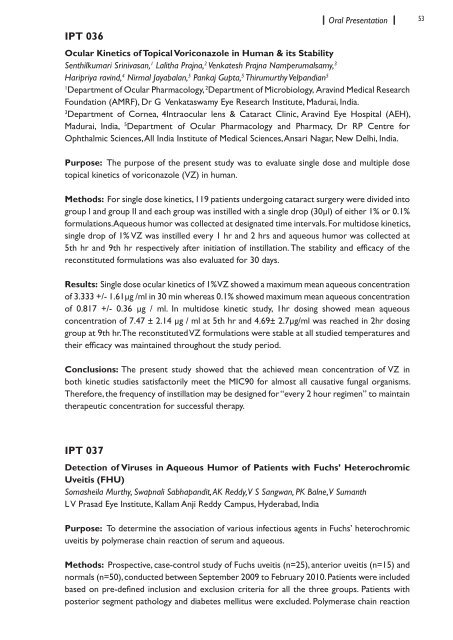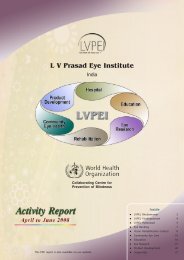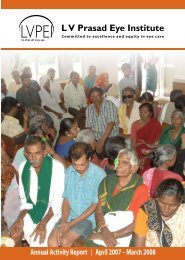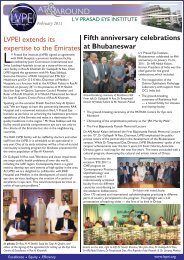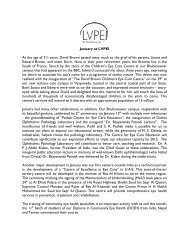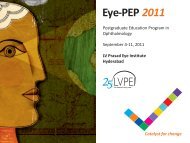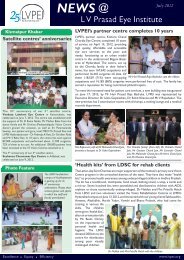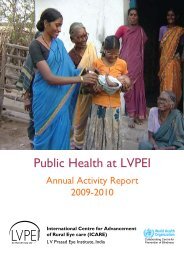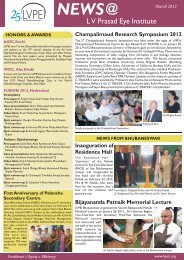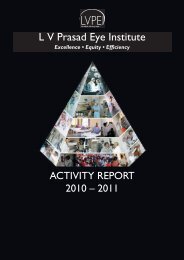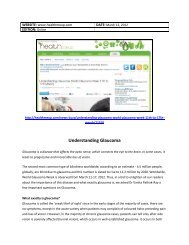IERG Abstracrt Book.indd - LV Prasad Eye Institute
IERG Abstracrt Book.indd - LV Prasad Eye Institute
IERG Abstracrt Book.indd - LV Prasad Eye Institute
Create successful ePaper yourself
Turn your PDF publications into a flip-book with our unique Google optimized e-Paper software.
IPT 036Oral Presentation53Ocular Kinetics of Topical Voriconazole in Human & its StabilitySenthilkumari Srinivasan, 1 Lalitha Prajna, 2 Venkatesh Prajna Namperumalsamy, 3Haripriya ravind, 4 Nirmal Jayabalan, 5 Pankaj Gupta, 5 Thirumurthy Velpandian 51Department of Ocular Pharmacology, 2 Department of Microbiology, Aravind Medical ResearchFoundation (AMRF), Dr G Venkataswamy <strong>Eye</strong> Research <strong>Institute</strong>, Madurai, India.3Department of Cornea, 4Intraocular lens & Cataract Clinic, Aravind <strong>Eye</strong> Hospital (AEH),Madurai, India, 5 Department of Ocular Pharmacology and Pharmacy, Dr RP Centre forOphthalmic Sciences, All India <strong>Institute</strong> of Medical Sciences, Ansari Nagar, New Delhi, India.Purpose: The purpose of the present study was to evaluate single dose and multiple dosetopical kinetics of voriconazole (VZ) in human.Methods: For single dose kinetics, 119 patients undergoing cataract surgery were divided intogroup I and group II and each group was instilled with a single drop (30µl) of either 1% or 0.1%formulations. Aqueous humor was collected at designated time intervals. For multidose kinetics,single drop of 1% VZ was instilled every 1 hr and 2 hrs and aqueous humor was collected at5th hr and 9th hr respectively after initiation of instillation. The stability and efficacy of thereconstituted formulations was also evaluated for 30 days.Results: Single dose ocular kinetics of 1% VZ showed a maximum mean aqueous concentrationof 3.333 +/- 1.61µg /ml in 30 min whereas 0.1% showed maximum mean aqueous concentrationof 0.817 +/- 0.36 µg / ml. In multidose kinetic study, 1hr dosing showed mean aqueousconcentration of 7.47 ± 2.14 µg / ml at 5th hr and 4.69± 2.7µg/ml was reached in 2hr dosinggroup at 9th hr. The reconstituted VZ formulations were stable at all studied temperatures andtheir efficacy was maintained throughout the study period.Conclusions: The present study showed that the achieved mean concentration of VZ inboth kinetic studies satisfactorily meet the MIC90 for almost all causative fungal organisms.Therefore, the frequency of instillation may be designed for “every 2 hour regimen” to maintaintherapeutic concentration for successful therapy.IPT 037Detection of Viruses in Aqueous Humor of Patients with Fuchs’ HeterochromicUveitis (FHU)Somasheila Murthy, Swapnali Sabhapandit, AK Reddy, V S Sangwan, PK Balne, V SumanthL V <strong>Prasad</strong> <strong>Eye</strong> <strong>Institute</strong>, Kallam Anji Reddy Campus, Hyderabad, IndiaPurpose: To determine the association of various infectious agents in Fuchs’ heterochromicuveitis by polymerase chain reaction of serum and aqueous.Methods: Prospective, case-control study of Fuchs uveitis (n=25), anterior uveitis (n=15) andnormals (n=50), conducted between September 2009 to February 2010. Patients were includedbased on pre-defined inclusion and exclusion criteria for all the three groups. Patients withposterior segment pathology and diabetes mellitus were excluded. Polymerase chain reaction


